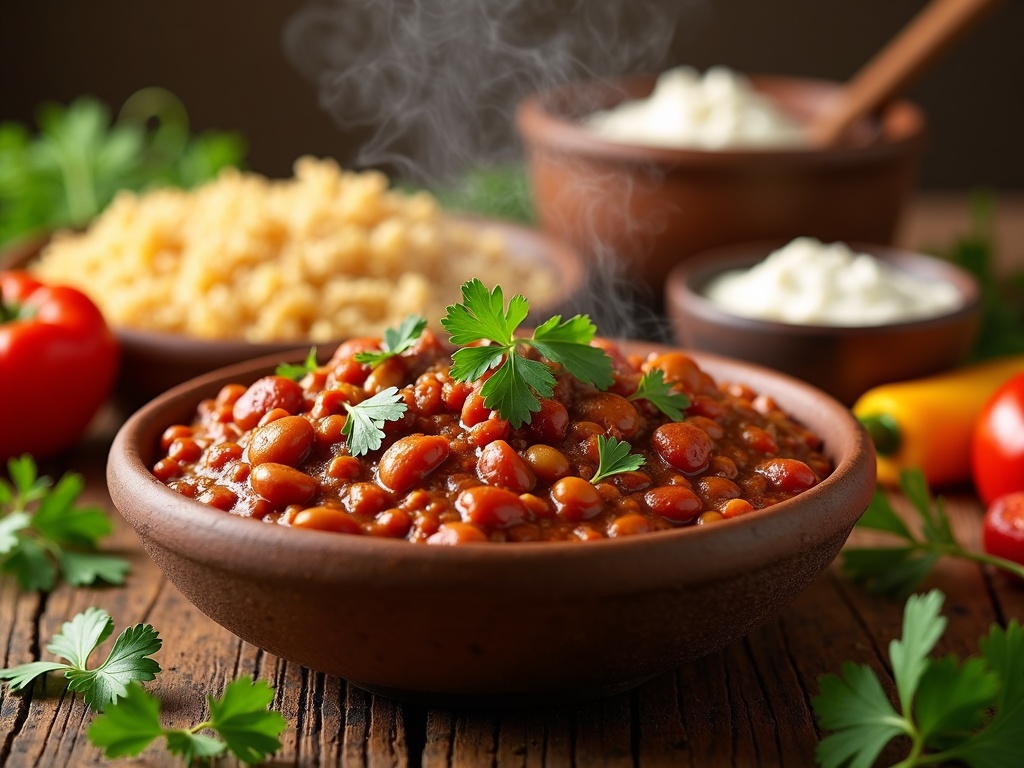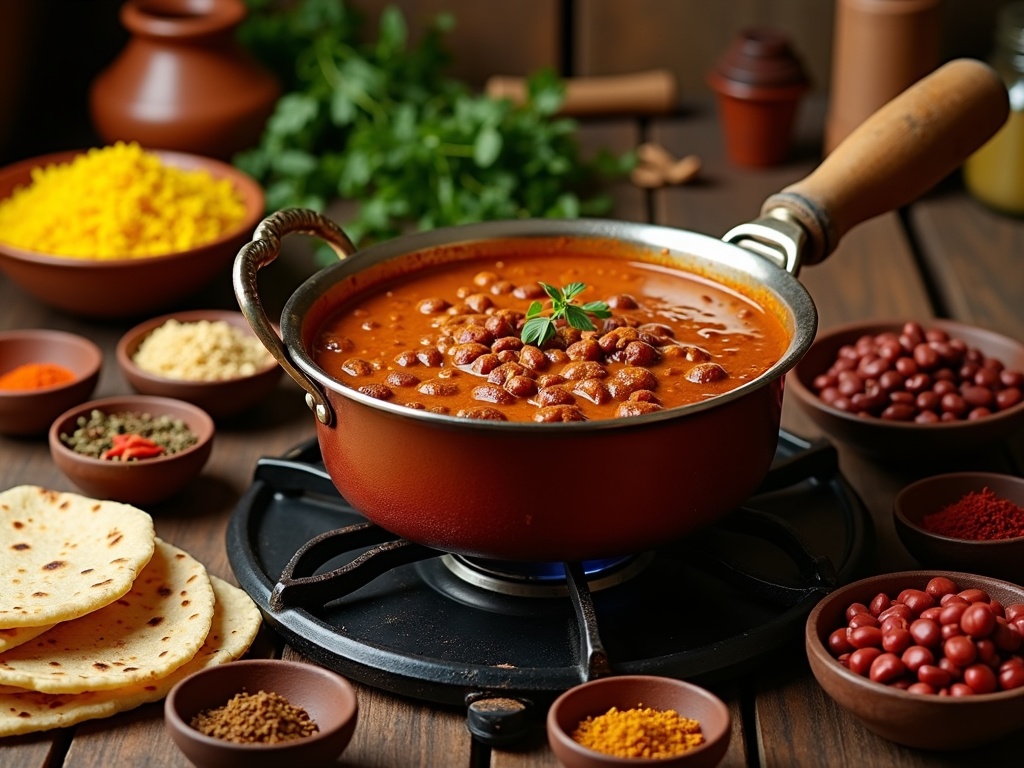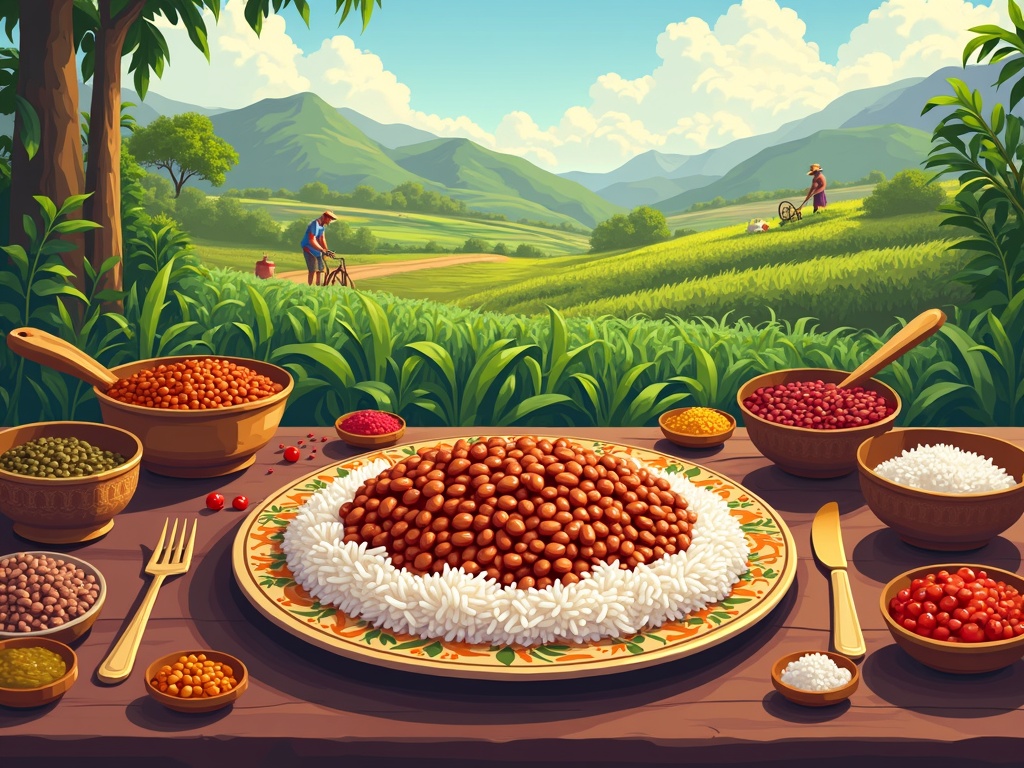Rajma, a beloved kidney bean curry originating from India, has established itself as a global culinary staple with significant nutritional and cultural importance. Beyond its rich flavor profile, rajma offers impressive health benefits through its protein-packed composition and low glycemic index, making it an ideal addition to balanced diets worldwide.
Find In This Article
Key Takeaways
- Rajma delivers 8.7 grams of protein per 100 grams with minimal fat content, making it an excellent plant-based protein source for vegetarians and meat-eaters alike.
- The low glycemic index of 29 and high fiber content (6.4g per 100g) help regulate blood sugar levels and provide sustained energy throughout the day.
- India leads global kidney bean production at 40%, supporting approximately 1.5 million farmers and generating significant economic value.
- Traditional preparation involves soaking dried beans overnight and cooking with distinctive spices like cumin, coriander, garam masala, and turmeric.
- Kidney bean plants naturally improve soil health through nitrogen fixation, reducing the need for chemical fertilizers and supporting sustainable farming practices.
The Global Significance of Kidney Beans
Kidney beans have established themselves as a culinary staple across numerous cultures, particularly in Indian cuisine where they feature in the beloved dish rajma. I’ve found that understanding the global footprint of these nutritious legumes adds another dimension to appreciating this comfort food.
Production Powerhouses
India stands as the undisputed giant in kidney bean production, contributing a remarkable 40% to the global supply. This impressive statistic highlights the country’s agricultural prowess in cultivating this protein-rich legume. While India leads the pack, kidney beans (scientifically known as Phaseolus vulgaris) are also primarily cultivated in Northern Mexico and Central America, creating a triangle of production regions that supply most of the world’s demand.
The economic impact of kidney bean cultivation can’t be overstated. In 2021 alone, India’s export value of kidney beans reached $165 million, demonstrating the significant commercial value of this humble legume. When I prepare vegetable curry recipes with kidney beans, I’m participating in a global food system with substantial economic implications.
Social and Cultural Importance
Beyond their economic value, kidney beans support the livelihoods of approximately 1.5 million farmers in India. This makes them not just a nutritional powerhouse but also a crucial source of income for agricultural communities. The cultivation practices have been refined over generations, with farmers developing specialized knowledge about optimal growing conditions.
Many rural economies in the primary cultivation regions depend heavily on successful kidney bean harvests. The ripple effect extends to local markets, processing facilities, and export businesses. I’ve noticed that kidney beans pair exceptionally well with jeera rice, creating a complete meal that’s both nutritious and satisfying.
Kidney beans have also transcended their agricultural roots to become cultural icons in many societies. In Northern India, a Sunday meal isn’t complete without rajma chawal (kidney bean curry with rice), while in Mexico, these beans form the foundation of numerous traditional dishes. This cultural significance helps maintain demand and ensures the continued prosperity of kidney bean farming communities worldwide.
Powerful Nutritional Profile
Rajma’s nutritional lineup makes it a powerhouse in any healthy diet. I consider it one of the most balanced foods available, offering substantial nutrients without excessive calories.
Protein and Macronutrient Balance
Rajma delivers an impressive 8.7 grams of protein per 100 grams when cooked, making it an excellent plant-based protein source for vegetarians and meat-eaters alike. With just 0.5 grams of fat, it’s practically fat-free while providing 22 grams of carbohydrates that fuel your daily activities. The combination creates a satisfying meal that keeps you full longer without weighing you down.
The protein content in rajma contains essential amino acids your body needs for muscle repair and growth. This makes it particularly valuable for:
- Post-workout recovery meals
- Vegetarian meal planning
- Budget-friendly protein options
- Children’s growth and development needs
Fiber Benefits and Blood Sugar Management
What truly sets rajma apart is its remarkable fiber content—6.4 grams per 100-gram serving. This fiber isn’t just good for digestion; it creates the perfect slow-release system for the carbohydrates in the beans.
Rajma boasts a low glycemic index of 29, placing it firmly in the “low GI” category of foods. This means the carbohydrates break down slowly, releasing glucose gradually into your bloodstream rather than causing rapid spikes. This steady energy release is essential for maintaining consistent energy levels throughout the day.
The fiber-carbohydrate combination in rajma creates several health advantages:
- Prolonged feeling of fullness, reducing snacking urges
- Stable blood sugar levels without dramatic peaks and valleys
- Sustained energy for physical and mental activities
- Support for digestive health and gut microbiome
When paired with jeera rice or fresh chapati, rajma creates a complete meal that balances protein, complex carbohydrates, and minimal fat—making it an ideal choice for anyone focused on nutritious eating without sacrificing flavor.
Game-Changing Health Benefits
Rajma, the protein-packed kidney bean curry, offers remarkable health advantages beyond its delicious taste. I’ve found that adding this nutrient-dense dish to my weekly meal rotation has made a noticeable difference in my overall wellbeing.
Powerful Health Impacts
Starting your day with a serving of rajma can help regulate blood sugar levels due to its low glycemic index. The slow-digesting complex carbohydrates in kidney beans prevent sudden spikes in blood glucose, making them a smart choice for anyone monitoring their sugar intake.
The heart-healthy benefits of rajma can’t be overstated. Regular consumption has been linked to reducing cardiovascular disease risk by up to 10%. This is largely due to the potassium content that helps maintain healthy blood pressure levels.
I’ve noticed improved digestive health since incorporating rajma into my diet. This comes from its impressive fiber content – a single cup provides nearly 45% of your daily fiber needs. This keeps everything moving smoothly through your digestive system and supports gut health.
If you’re watching your cholesterol, rajma deserves a spot on your plate. Here’s how kidney beans aid in cholesterol management:
- They contain soluble fiber that binds to cholesterol in the digestive system
- Their plant-based protein offers a healthy alternative to animal proteins
- The folate content supports healthy heart function
- Their high antioxidant content fights inflammation
For those focused on weight management, rajma provides satisfying fullness without excessive calories. The combination of protein and fiber keeps hunger at bay for hours after eating a flavorful bean curry.
The sustained energy release from rajma makes it perfect for active lifestyles. Unlike refined carbs that cause energy crashes, kidney beans deliver steady fuel through complex carbohydrates. I’ve found this particularly helpful for maintaining energy throughout busy afternoons when paired with jeera rice for a complete meal.
What makes rajma truly exceptional is its nutritional density – delivering substantial vitamins, minerals, and plant compounds in each serving. The iron content supports healthy blood cells, while the manganese and copper contribute to overall metabolic health.

Traditional Indian Preparation and Beyond
I’ve found that rajma holds a special place in North Indian cuisine, especially when prepared as the signature dish Rajma Chawal – a comforting combination of spiced kidney beans served with steamed rice. This protein-rich meal is a staple in many Indian households, particularly in the Punjab region where it originated.
Classic Cooking Methods and Spices
Traditional rajma preparation requires proper soaking of dried kidney beans overnight before cooking. After soaking, I prefer pressure cooking the beans as it significantly reduces cooking time while ensuring they become perfectly tender. For those who aren’t in a rush, slow cooking rajma on low heat allows the beans to absorb the aromatic spices gradually, creating deeper flavor profiles.
The distinctive taste of rajma comes from its characteristic spice blend. I typically use:
- Cumin seeds for a warm, earthy base
- Ground coriander for citrusy notes
- Garam masala for complex depth
- Red chili powder for heat
- Turmeric for color and health benefits
- Dried mango powder (amchur) for tanginess
A properly prepared rajma curry has a thick, luscious gravy that coats each bean perfectly, making it ideal to enjoy with homemade chapati or fluffy rice.
Global Adaptations and Versatility
Rajma’s versatility extends far beyond the traditional curry. I’ve experimented with numerous creative variations including Rajma Masala (a drier, more intensely spiced version), Rajma Burgers (mashed beans formed into patties), and Rajma Tacos (an Indian-Mexican fusion). The earthy flavor of rajma pairs beautifully with jeera rice but works equally well in fusion dishes.
Interestingly, kidney beans feature prominently in Mexican cuisine as well, most notably in chili con carne and refried beans. The similarities between Indian rajma and Mexican bean dishes highlight the universal appeal of this ingredient across culinary traditions.
I often incorporate rajma into various meal preparations beyond curry – they make excellent additions to hearty vegetable stews, cold salads with lemon dressing, or even blended into dips similar to hummus. Their meaty texture makes them a fantastic protein source in vegetable curry recipes, offering substance and nutrition.
The adaptability of rajma makes it an ideal ingredient for experimenting with cross-cultural cooking techniques, proving that this humble bean deserves recognition beyond its traditional preparation.

Environmental and Agricultural Impact
Rajma, or kidney beans, play a remarkable role in our agricultural ecosystem beyond just being a delicious curry ingredient. I’ve observed how these humble beans contribute significantly to environmental sustainability through their natural biological processes.
Soil Health and Sustainability
Rajma plants are incredible natural soil engineers. They contribute to nitrogen fixation—a process where the plant’s root nodules host special bacteria that convert atmospheric nitrogen into a form plants can use. This natural fertilization reduces the need for chemical nitrogen fertilizers, making bean cultivation more eco-friendly and cost-effective for farmers.
The benefits don’t stop there. When rajma crops are rotated with other plants, they enhance soil fertility naturally. After harvest, the remaining plant matter decomposes and releases stored nitrogen back into the soil, creating a nutrient-rich environment for subsequent crops. This natural cycle supports sustainable farming practices by:
- Reducing dependency on synthetic fertilizers
- Decreasing agricultural runoff pollution
- Improving soil structure and water retention
- Promoting biodiversity in the farming ecosystem
In India, rajma cultivation thrives particularly in the mountainous regions of Himachal Pradesh and the fertile plains of Uttar Pradesh. These areas have developed specialized farming techniques that maximize the bean’s environmental benefits while producing high-quality crops. Farmers in these regions have passed down traditional knowledge for generations, creating a sustainable food system that respects the land.
The agricultural significance of rajma extends to broader sustainability initiatives. As climate change concerns grow, rajma has become a key crop in sustainable agriculture programs across India. Its relatively low water requirements compared to many other protein sources make it an excellent option for areas experiencing water stress. Additionally, its ability to grow in diverse soil conditions makes it resilient against changing climate patterns.
By incorporating rajma into crop rotation systems, farmers can maintain productivity while reducing their environmental footprint—a practice increasingly recognized by agricultural extensions and sustainability programs throughout the country.

Sources:
Food and Agriculture Organization (FAO), Journal of Nutrition, AgMarkNet, Indian Council of Agricultural Research (ICAR)

